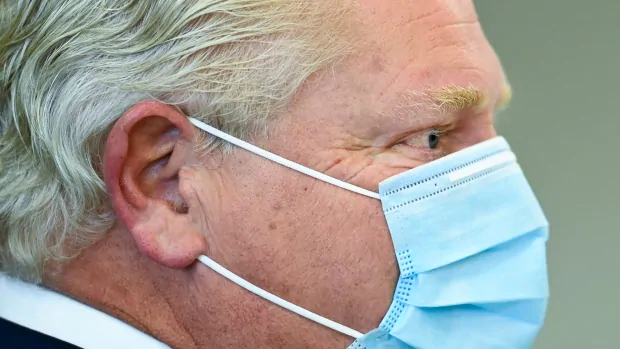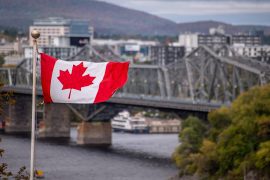Ontario will release updated modelling on Thursday forecasting the course of its second wave of COVID-19, as some epidemiologists already project the province will surpass 2,000 new cases per day by early December.
This comes as Ontario sees a renewed surge in infections, despite recent comments by Premier Doug Ford suggesting the pandemic curve is flattening or going down.
Over the past week, Ontario has reported a daily average of more than 1,200 new confirmed cases of COVID-19, and on four of the past five days, the province broke its previous single-day record.
Based on the growth rate of new cases in early November, Ontario is on track for 2,000 cases a day around Dec. 1, according to recent projections by the COVID-19 Modelling Collaborative. Work by this group — which includes scientists and physicians from the University of Toronto, University Health Network and Sunnybrook Hospital — has fed into the province’s own modelling forecasts.
“Given the policies that we have in place right now, I don’t think there’s any reason to conclude that we wouldn’t reach 2,000 cases a day,” said Ashleigh Tuite, an infectious diseases epidemiologist at the University of Toronto’s Dalla Lana School of Public Health, who is not part of the Modelling Collaborative team.
“We’d have to start seeing a huge change in terms of the restrictions that we have in place to not hit 2,000,” said Tuite in an interview with CBC News. “We’re on this trajectory and we’re not doing enough at this point to change that trajectory.”
The provincial government has placed only two of Ontario’s 34 public health units in the “red zone” alert level: Toronto (starting this weekend) and Peel Region. In both areas, the medical officers of health have decided the province’s red zone restrictions are insufficient to slow the spread of the virus and have announced additional measures.
Ontario’s updated modelling will be made public at a news conference Thursday by a trio of doctors: David Williams, Ontario’s chief medical officer of health; Dirk Huyer, the chief coroner and co-ordinator of provincial outbreak response; and Adalsteinn Brown, dean of the Dalla Lana School of Public Health and co-chair of Ontario’s COVID-19 science advisory table.
The modelling is expected to show not only the projected trend of new cases but also the potential implications for Ontario’s hospitals. The latest provincial figures released Wednesday show 424 hospital patients with COVID-19, including 88 in intensive care.
An average of 2,000 cases per day would put Ontario on the cusp of a critical benchmark. Over the course of a week, that works out to about 96 new cases per 100,000 population. The province’s official threshold for red zone restrictions is 100 cases weekly per 100,000 population.

The last time Ontario released modelling, at the end of October, Ford hinted that it would show good news. “We see the curve going down,” he said one day before the modelling was released publicly, showing nothing of the sort.
The modelling did suggest the rate of increase in new COVID-19 cases was slower than it had been in previous weeks, but infections were still on the rise. The modelling also projected that by mid-November, the daily average of new cases could be as high as 1,200 — a level Ontario surpassed on Wednesday.
In just five weeks, Ontario schools begin their winter holidays. Without a change in public health restrictions, Tuite sees little prospect that the province’s curve will flatten soon enough that people will be able to celebrate the holidays safely with friends and family outside their household.
“In the absence of change , the chance of cases being in decline by Christmas is very, very low,” said Tuite.
“This isn’t going to, on its own, just stop growing,” she said. “We need to do something to change the course of the epidemic. There’s not a version of reality where suddenly the virus just stops growing on its own and things are looking OK by the end of December.”
Williams, the chief medical officer of health, sees things differently. On Monday, he described what he admitted was a “pretty aspirational” scenario of all Ontarians practicing physical distancing, having no close contact with anyone outside their household and always wearing masks in public places.
“If everybody does what they’re supposed to do … we could drive the whole province down to the green level (of COVID restrictions) in about three to four weeks,” Williams said. Based on the province’s criteria for the green zone, that would mean roughly 200 new cases per day, a rate Ontario hasn’t seen since early September.
Modelling the second wave of the COVID-19 pandemic is proving more challenging than the first, said Tuite, because so many factors that influence the infection rate are shifting. Among them: government policies and human behaviour.
She said it makes no sense right now to produce models that run two months into the future because a significant surge in new infections could prompt people to alter their behaviours or prompt government to tighten public health restrictions, which in turn would change the trajectory of the pandemic.
And that means she can’t predict when Ontario’s second wave will peak, nor how high it will grow.

Devoted web advocate. Bacon scholar. Internet lover. Passionate twitteraholic. Unable to type with boxing gloves on. Lifelong beer fanatic.





